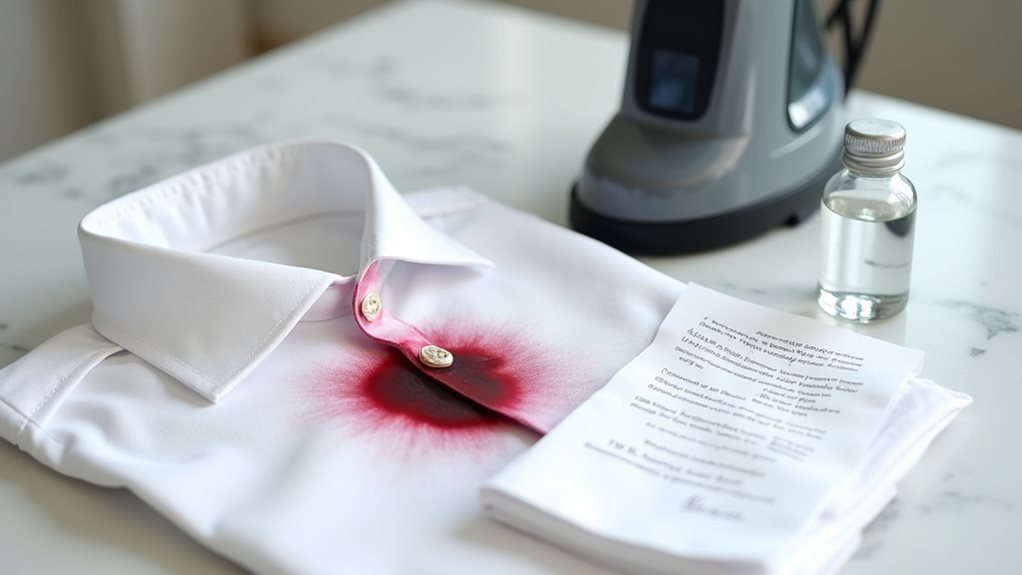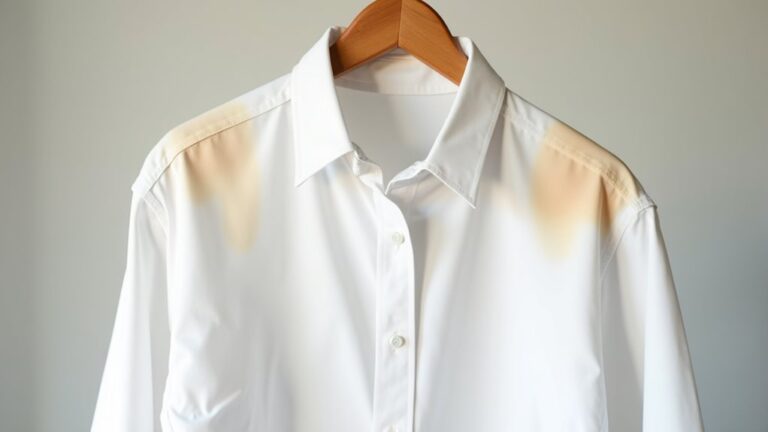Dry cleaning can remove blood stains, but success depends on several significant factors that’ll determine whether you’re celebrating or crying into your coffee. Professional cleaners use enzyme-based solutions that literally digest blood proteins, which sounds wonderfully scientific until you realize that older stains have already formed stubborn molecular bonds with your fabric. Fresh blood responds much better than that week-old stain you’ve been avoiding, and delicate synthetics can be particularly challenging to treat without damage. The type of fabric, amount of blood, and any previous home treatment attempts all influence your chances of success, so honesty with your cleaner about the stain’s history helps them choose the most effective approach for your specific situation.
Understanding the Nature of Blood Stains
Although you might think all stains are created equal, blood stains present their own unique challenges that’ll make you appreciate the science behind fabric care.
When blood hits your favorite shirt, you’re dealing with a complex mixture of water, red blood cells, and proteins like hemoglobin that bond aggressively with fabric material. Fresh blood stains are your best friend in the stain removal game – they haven’t had time to set their stubborn roots deep into the fibers.
However, old stains become protein powerhouses that laugh in the face of basic cleaning methods. The cleaning process becomes trickier as blood proteins fundamentally “cook” into the fabric, which is why dry cleaning solvents work best when you act fast to remove blood stains effectively. Since blood is a protein-based stain, it typically responds better to water-based treatments rather than the chemical solvents used in traditional dry cleaning processes.
How Dry Cleaning Works on Protein-Based Stains
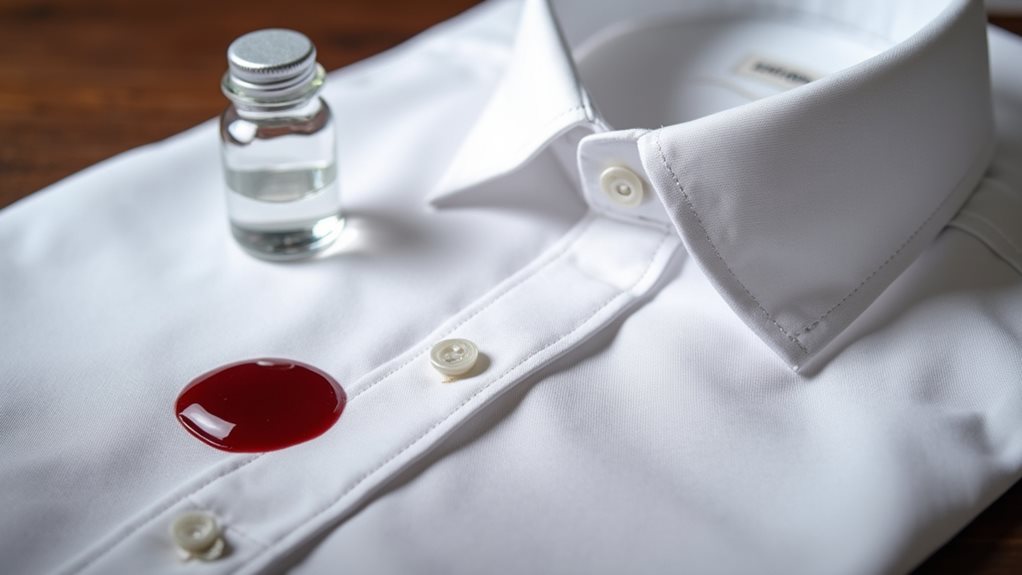
When your dry cleaner gets their hands on that blood-stained garment, they’re fundamentally becoming a molecular matchmaker, pairing the right solvents with stubborn protein chains that have made themselves comfortable in your fabric’s fibers.
Their specialized techniques target protein-based stains differently than your typical wine spill, using enzyme-based solutions that literally digest the proteins holding those blood stains together.
Think of it like sending tiny Pac-Man creatures to munch through the molecular bonds!
The solvents, particularly perchloroethylene, work overtime dissolving oils and grease while enzymes tackle the protein components.
However, here’s the reality check: prompt treatment greatly improves your odds, but complete removal isn’t always guaranteed.
Older stains become stubborn houseguests, markedly reducing visibility of stains rather than achieving total elimination.
For delicate fabrics that cannot withstand machine washing, dry cleaning often provides the safest method to attempt blood stain removal without causing fabric damage.
Factors That Affect Blood Stain Removal Success
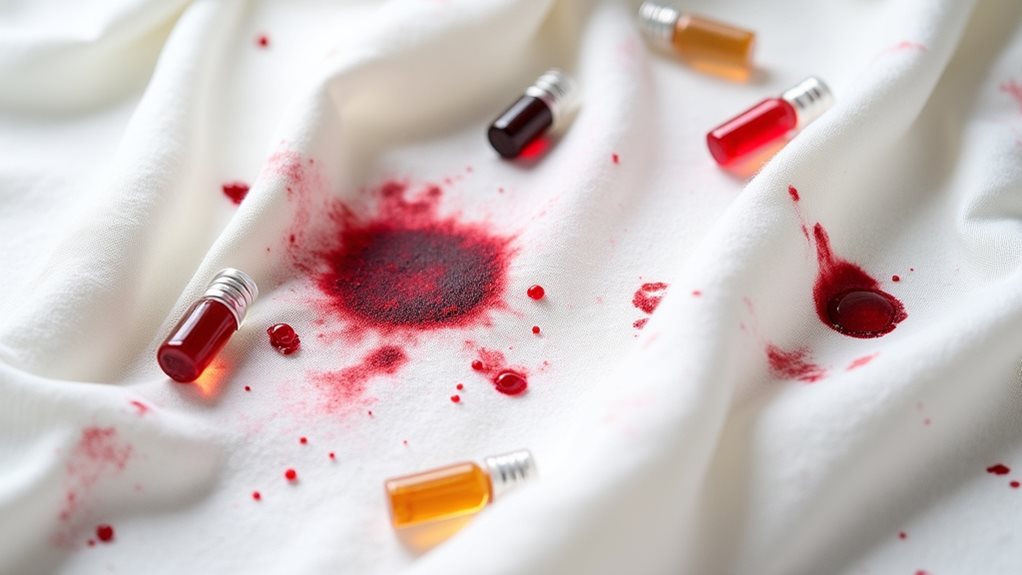
Success in blood stain removal isn’t just about having the right equipment and expertise at your disposal, it’s about timing, fabric compatibility, and a handful of variables that can make or break your garment’s second chance at life.
The age of the blood stain matters tremendously—fresh stains practically melt away under the right dry cleaning solvents, while older ones cling stubbornly to fibers like they’re holding on for dear life.
Your type of fabric plays matchmaker here; cotton and wool welcome these protein-based treatments beautifully, but delicate materials like silk need gentler, customized approaches.
Communication becomes your secret weapon—tell your cleaner everything about the stain, because early intervention and the right strategy dramatically improve your success of removal odds.
The amount of blood present also influences the outcome, as deeply embedded stains may prove permanent even with professional treatment.
What to Expect When Taking Blood-Stained Items to Dry Cleaners
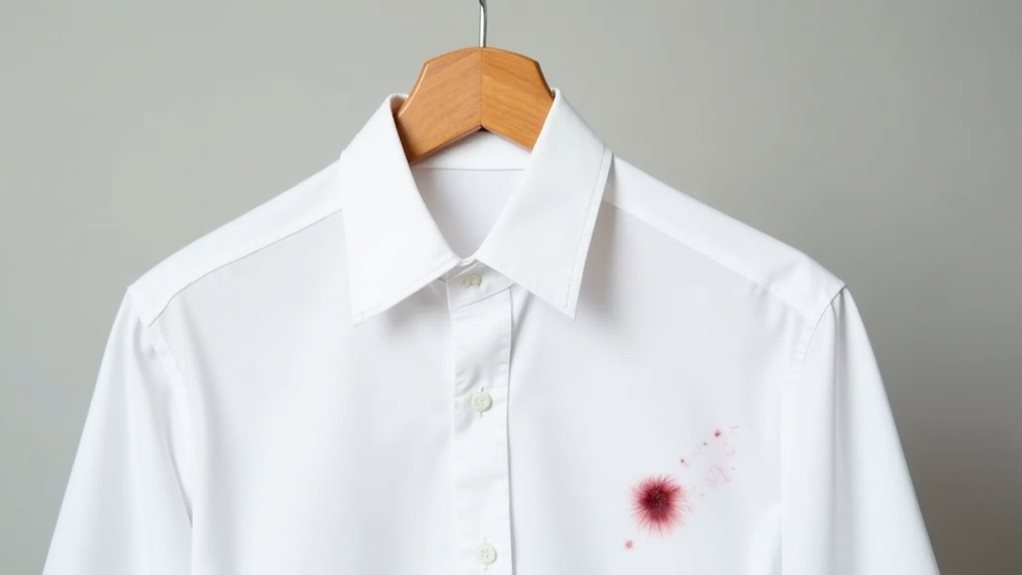
When you walk into a dry cleaner with a blood-stained garment, you’ll quickly discover that their first step involves a thorough examination of the fabric, the stain’s age, and its severity—much like a detective studying evidence at a crime scene.
The professional will likely ask you pointed questions about when the stain occurred and what type of blood it’s (yes, they really do ask that sometimes 😅), because these details directly impact their treatment strategy and your expectations.
You shouldn’t expect miracles, but you can anticipate honest feedback about whether your favorite shirt has a fighting chance or if you’re looking at a lost cause.
Blood is considered a protein-based stain that dry cleaning can effectively handle, especially when compared to traditional water-based washing methods that may actually set the stain deeper into the fabric.
Professional Assessment Process
Although you might feel a bit sheepish walking into a dry cleaner with blood-stained clothing, professional cleaners have honestly seen it all—from nosebleeds on wedding dresses to cooking mishaps on favorite shirts—so there’s no need to craft an elaborate backstory about your “tomato sauce incident” 😅.
When you arrive, professional dry cleaners will conduct a thorough assessment, examining the fabric type, stain characteristics, and age of the blood stains to determine the most effective treatment methods.
They’ll ask specific questions about when the stain occurred and what fabric you’re dealing with, since different materials require specialized approaches during the cleaning process.
This detailed evaluation helps them predict realistic outcomes for stain removal before beginning any treatment.
The cleaner will also inquire about any previous cleaning attempts you may have made at home, as certain treatments or exposure to heat can permanently set the stain and affect the specialized solvents used in the dry cleaning process.
Realistic Outcome Expectations
Why do expectations matter so much when you’re standing at that dry cleaning counter, clutching your stained garment like a lifeline?
Because understanding what’s actually possible saves you from heartbreak later. While dry cleaning can remove fresh blood stains effectively, older stains present bigger challenges – think stubborn houseguests who’ve overstayed their welcome.
Delicate fabrics require gentler approaches, meaning completely removal isn’t always guaranteed, especially on whites where every trace shows.
Here’s my hard-learned wisdom: informing the dry cleaner about your specific types of fabric and stain timeline helps them choose appropriate treatment, maximizing chances of success.
Don’t expect miracles on set-in stains, but do expect honest professionals who’ll tell you upfront whether they can remove the blood stain completely.
Blood falls into the category of protein-based stains, which are notoriously more challenging for dry cleaning solvents to break down compared to oil-based stains.
Pre-Treatment Steps Before Professional Cleaning
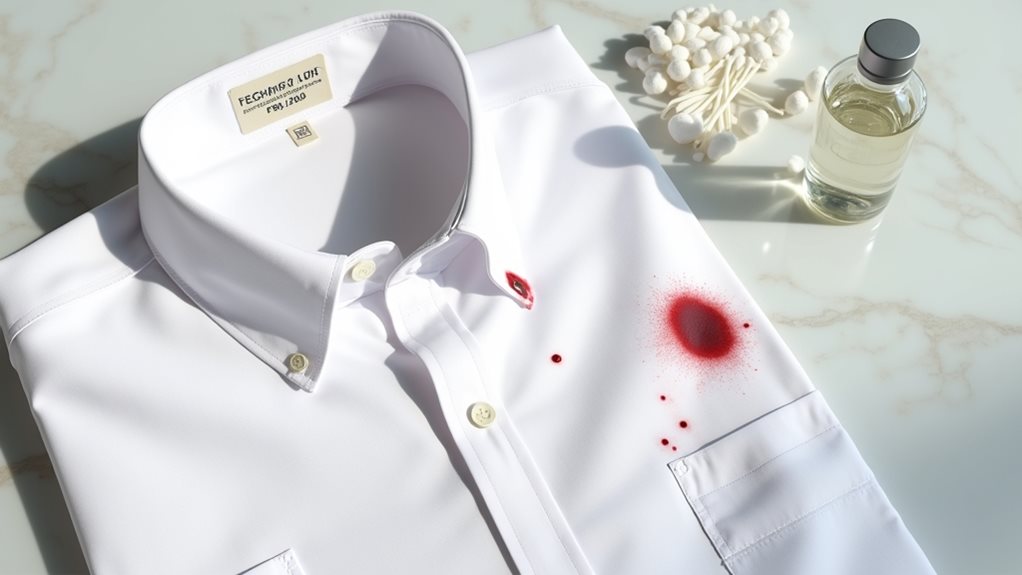
Three critical steps can make the difference between a stain that disappears completely and one that becomes a permanent reminder of an unfortunate moment, and I learned this the hard way when I ruined my favorite silk blouse by panicking and using hot water on a nosebleed stain.
First, immediately rinse the blood stain with cold water – never hot, which bonds proteins to fabric fibers permanently.
Hot water is blood’s best friend and your fabric’s worst enemy – it permanently locks protein stains into fibers.
Next, gently blot with a dry cloth to remove excess blood without spreading it further across your garment.
Finally, apply cold water mixed with mild detergent directly onto the stain, letting it sit briefly before rinsing.
These simple pre-treat steps dramatically improve your dry cleaners’ ability to remove stubborn blood stains during professional cleaning. Just like with ink stains, acting quickly is essential because the longer any stain sets into fabric fibers, the more challenging it becomes for even professional solvents to achieve complete removal.
Alternative Methods for Stubborn Blood Stains
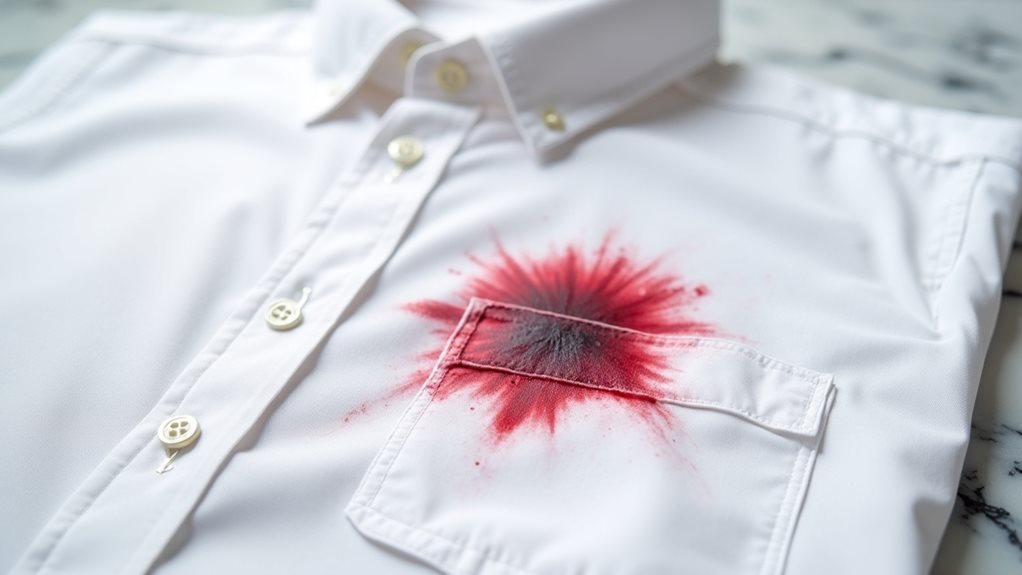
When dry cleaning doesn’t completely banish those stubborn blood stains, you’ve got some surprisingly effective backup plans that I’ve learned through years of laundry mishaps and kitchen accidents.
You can try home remedy solutions like hydrogen peroxide (which literally bubbles away at blood proteins like tiny cleaning soldiers), enzyme-based stain removers that break down those pesky protein chains, or even create a paste with baking soda and cold water for set-in stains.
If these DIY approaches still leave you frustrated, professional stain services offer specialized treatments that go beyond standard dry cleaning, combining industrial-strength solutions with expert techniques that can tackle even the most determined blood stains.
Remember that chemical solvents used in traditional dry cleaning work best on oil-based stains rather than water-based stains like blood, which is why these alternative approaches are often necessary.
Home Remedy Solutions
Several times throughout my years of dealing with laundry mishaps, I’ve discovered that your kitchen cupboard holds some surprisingly powerful weapons against stubborn blood stains that refuse to budge with regular washing.
These home remedies have saved countless garments from the donation pile, and honestly, they work better than most expensive commercial products I’ve tried.
Here are my go-to solutions for treating blood stains:
- Hydrogen peroxide – Apply directly to the stain, then dab with a damp cloth to lift proteins
- Saltwater solution – Mix one cup salt with two quarts water, soak for 30 minutes
- Lemon juice and baking soda paste – Let sit 30 minutes before cold water rinse
- Enzyme-based stain removers – Target blood proteins effectively
Always test any home remedy on hidden fabric areas first, especially with delicate garments.
Unlike dry cleaning which uses chemical solvents rather than water, these home remedies are water-based treatments that can be more effective against protein-based stains like blood.
Professional Stain Services
While home remedies can work wonders on fresh blood stains, I’ve learned the hard way that some stubborn, set-in stains require the heavy artillery that only professional stain services can provide.
Professional cleaners bring specialized enzyme-based solutions that actually break down blood proteins, something your kitchen cabinet remedies simply can’t match. They’ll assess your specific stain’s age and type, then create customized treatment plans that target even the most stubborn stains with laser precision.
What I love about professional services is their advanced techniques—they’ll use multiple soaking cycles and specialized equipment that most of us don’t have at home.
Plus, immediate attention from experts dramatically improves your chances of successful stain removal, since they know exactly which appropriate cleaning agents work best for removing blood from different fabrics.
Dry cleaning is particularly effective for blood stains since it uses chemical solvents instead of water, making it ideal for delicate fabrics that cannot withstand traditional washing methods.
Limitations of Dry Cleaning for Blood Removal
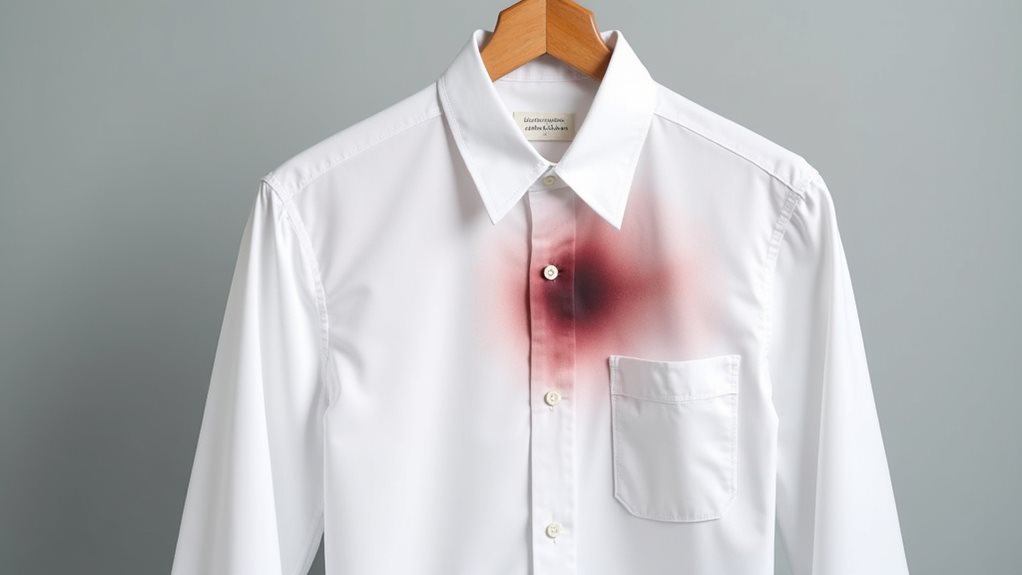
Although dry cleaning can work wonders on many stubborn stains, it’s not always the miracle solution we hope for when dealing with blood, and I learned this the hard way after my daughter’s soccer uniform incident last spring.
Sometimes the most trusted cleaning methods fall short when you need them most, leaving you scrambling for alternatives.
While dry cleaners can remove many challenging stains, blood presents unique obstacles that even professionals struggle with sometimes.
Here are the main limitations of dry cleaning for blood removal:
- Age matters tremendously – older stains that have set into fabric fibers resist even professional treatment.
- Fabric type affects success – delicate synthetics don’t respond as well as natural materials.
- Blood proteins bond stubbornly – dried blood creates molecular connections that complicate the stain removal process.
- Partial stain removal often occurs when solvents can’t fully break down set-in stains.
Informing the dry cleaner about specifics helps achieve best results, though removing tough stains isn’t always guaranteed.
Best Practices for Preventing Permanent Blood Stains

When it comes to blood stains, your best defense is always a swift offense, and I can’t stress enough how much heartache you’ll save yourself by acting within those crucial first few minutes after an accident happens.
I’ve learned this lesson the hard way after ruining my favorite white shirt 😅 – now I act quickly whenever these mishaps occur.
Start by blotting gently with cold water, never hot, since heat makes proteins bond permanently to fabric fibers.
Enzyme-based stain removers work wonders because they specifically target blood proteins, making them far superior to regular cleaners.
These best practices help you treat stains effectively before they become the dry cleaners’ problem, and trust me, you’ll remove the stain much easier this way than waiting.

